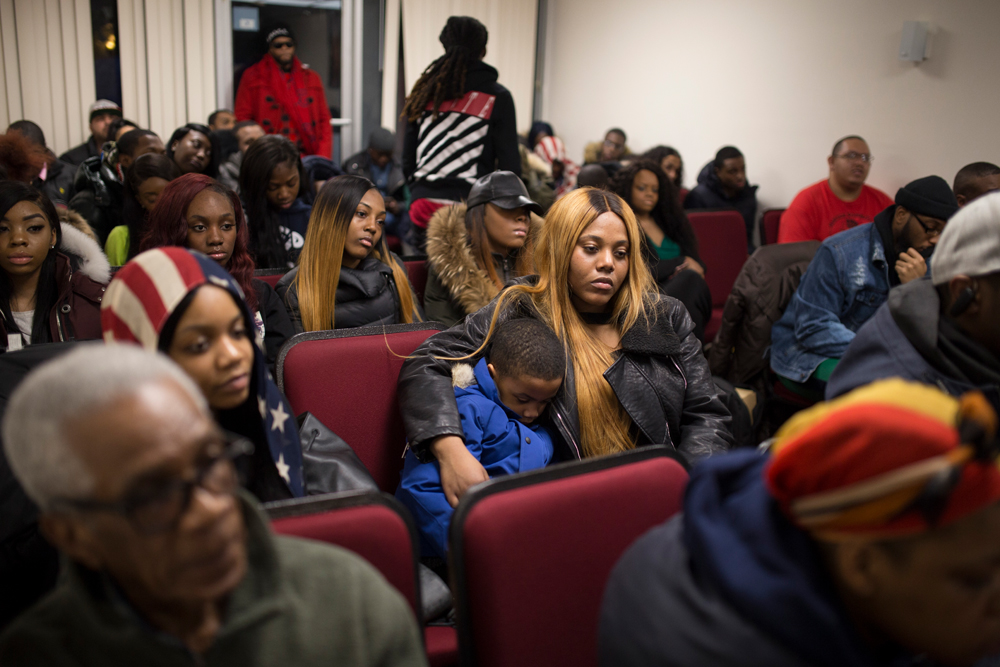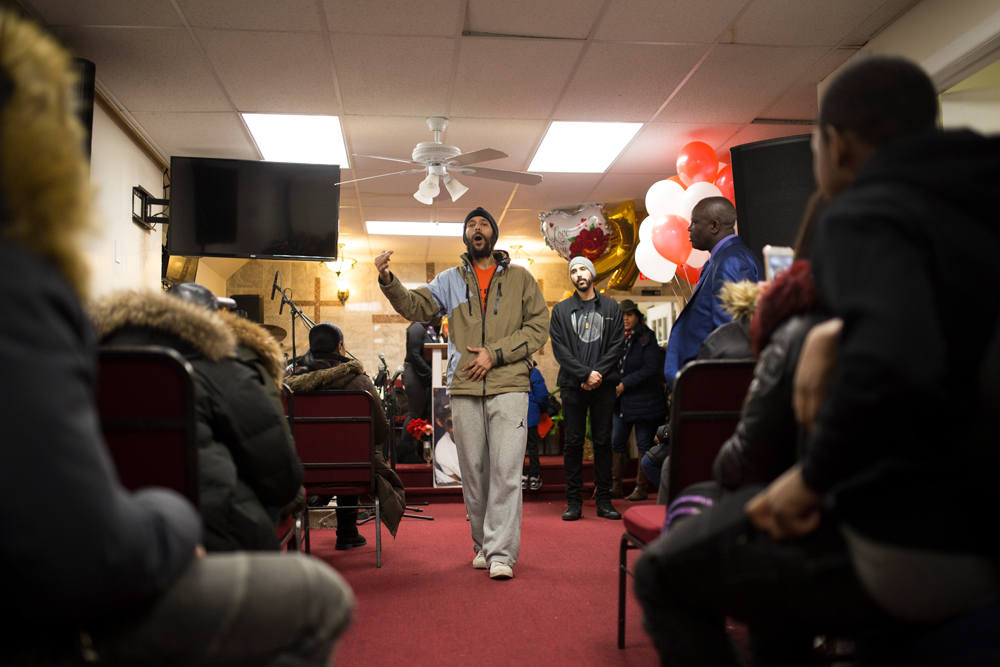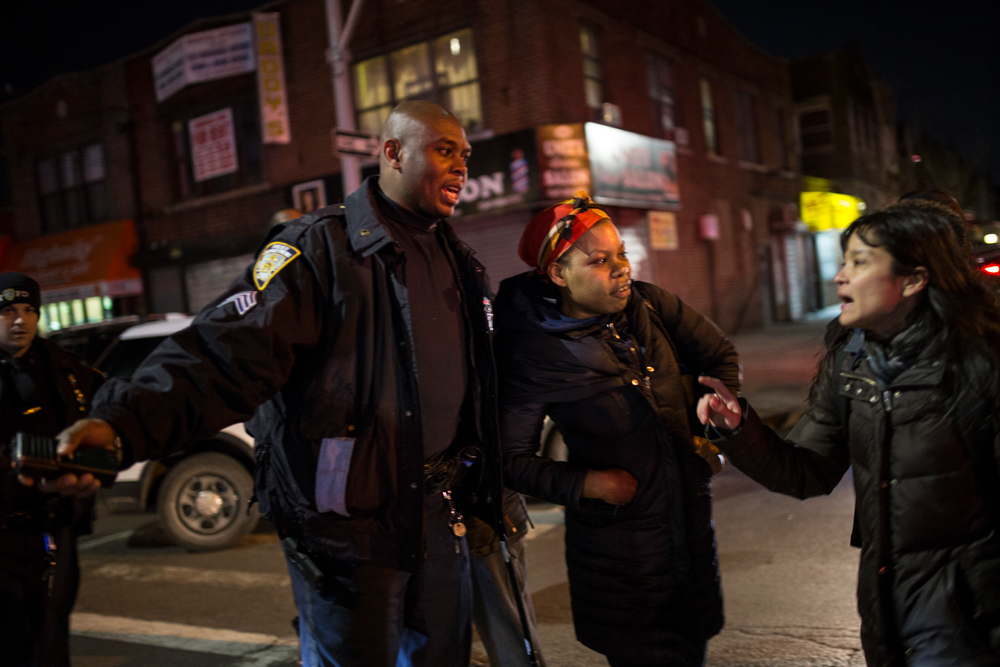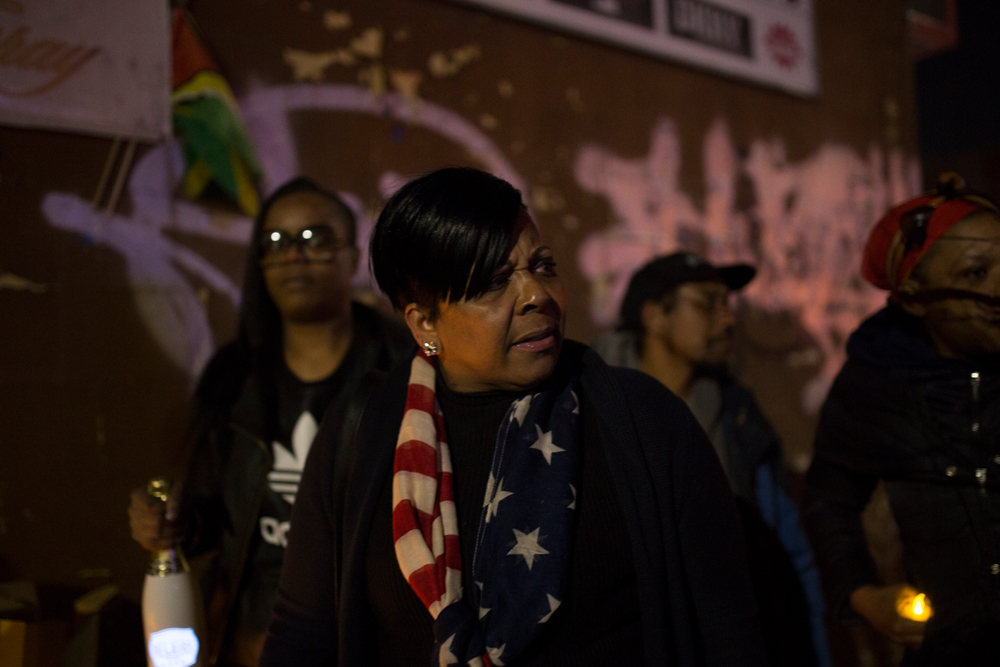NEW YORK — The first indication that the police were following the crowd gathered to remember the teenager shot to death by police five years earlier was the abrupt flash of police lights from an unmarked Chevy Challenger. Moments later police cars and vans blocked off the intersection at East 55th Street and Church Avenue in the East Flatbush neighborhood of Brooklyn.
 New York Police Department officers waded into the crowd threatening to arrest the young people who had gathered to commemorate their friend, shot under controversial circumstances on the evening of March 9, 2013. Some of them held balloons they were going to release as part of a tribute to Kimani Gray. But their plans threatened to unravel as tensions between the officers and the protesters mounted.
New York Police Department officers waded into the crowd threatening to arrest the young people who had gathered to commemorate their friend, shot under controversial circumstances on the evening of March 9, 2013. Some of them held balloons they were going to release as part of a tribute to Kimani Gray. But their plans threatened to unravel as tensions between the officers and the protesters mounted.

Family, friends and activists gathered at the Byways and Hedges Youth for Christ Ministry in Brooklyn to remember Kimani Gray. Gray was 16 years old when he was shot and killed by the New York Police Department on a street corner just blocks away from the church.
Kimani Gray was 16 when he was pronounced dead at Kings County Hospital after two plainclothes officers fired 11 shots at him for brandishing a .38 revolver. (Facts surrounding the shooting remain deeply contentious: Police said he had a gun, some eyewitnesses said the police planted the gun after the shooting.)
Yul-san Liem, an organizer of the protest/vigil, confronted the community affairs officer, begging them to tell their officers to stop intimidating the young people. Carol Gray, Kimani’s mother, scrambled from one group of youth to another, placing herself between the officers and her son’s friends. Anthony Beckford, the captain of the Brooklyn CopWatch Patrol Unit, barked at police to “call off their dogs.” At any moment, the event — ostensibly a candle-lighting commemoration for a dead teen — could turn ugly.
Memories and tears in church
The public clash on the street was a sharp departure from the solemn atmosphere at the storefront church where the group of activists, family and friends had spent the prior two hours remembering Kimani. They had gathered in the nearby Byways and Hedges Youth for Christ Ministry, about a half-dozen blocks from where NYPD Sgt. Mourad Mourad and Officer Jovaniel Cordova shot Kimani. All the seats in the small storefront church were taken, and a few guests needed to lean against the wall.
One after another the crowd took turns remembering Kimani and the youth-led movement that sprang to life in the wake of his killing. Before the informal ceremony started, minister Terry Lee asked for a moment of silence for all the mothers who had lost children to police violence.
Other such mothers were in the crowd: Hawa Bah, whose son Mohamed was shot to death in Harlem; Constance Malcolm, whose son Ramarley Graham was shot to death in his bathroom in the Bronx. There were also siblings and uncles of victims of police violence. They are family who have become part of a network of families tied together by tragedy. But they are also activists at the forefront of a civil rights movement working to end police violence and reform the NYPD.

The Peace Poets performed at the five-year memorial service for Kimani Gray.
When Carol Gray, the mother of Kimani, took the microphone, she struggled to maintain her composure. In the days and weeks and months after her son was fatally shot by police, well-intentioned people tried to comfort her with words of encouragement: It will get easier, they promised. Give it some time.
But it hasn’t. On the fifth anniversary of her son’s death at the hands of two members of the NYPD, Gray looked shell-shocked as she stood in front of a picture of her son in the pulpit. Two large golden balloons were tied to it, one a “K,” the other a “G.” Another bunch of balloons were tied to a wilting plant.
It doesn’t get better
Each year gets more difficult, Gray said. Every anniversary she is haunted by what could have been: She wonders what he would be doing. What would he look like if he had had a chance to grow into a young man? Would he have gone to college? Would he have had a child? Would it be a daughter or a son?
“Every year it gets harder and harder,” she said as she prepared for a prayer vigil to honor her son’s memory. “It’s been a hard five years, it’s been really rough. The older he gets, the harder it gets for me.”
She talked about how Kiki, her nickname for him, rode around the neighborhood on his Big Wheels bike before his feet could reach the pedals. How the first thing he would always ask her was what she was cooking when he came home. How she named her son Kimani because it meant sailor and adventurer, and she thought her son would travel the world.
“He was his mom’s hope and joy. This is what the NYPD took from this family, from this community that night,” said Liem, the co-director of the Justice Committee, a social justice organization that helped organize the event. “We’re here to say that this has to stop.”
Monique Waterman, the founder of East Flatbush Village, a youth development organization, said she is inspired by Carol Gray’s activism in the face of tragedy.
“I’m a mother, too,” she said, turning to look at Gray. “I don’t know where you get the strength to do what you do,” her voice beginning to crack. “It’s always there, it’s always lingering. She knows that this community is hurting. That there’s trauma. And we keep getting retraumatized!”
She also referred to the organic street protests that arose in the wake of the shooting, and applauded the young people in the audience.
“I am so proud of the youth,” she said, motioning to the dozens of young adults and teenagers assembled in the church. “They are the future. No matter how much the police try to oppress you, you know that you are in the right. I want you to use your energy to do something positive. They all think that you are going to give up. But keep it up; keep proving them wrong.”
‘They are with us still’
Mahnefah Gray, Kimani’s older sister, implored her brother’s friends, all of whom had sat in the back rows of the church, to come up and say something. She finally settled on one young man and dragged him up to the front of the church. He was visibly uncomfortable and bowed his head as she put her arm around his shoulder and encouraged him to speak.
He said he didn't like talking in front of people, making a few awkward attempts before he became overwhelmed with grief. Embarrassed, he began to cry. Through sobs, he muttered, “I’m good, I’m good,” covered his face with his hands and dashed from the pulpit.
Before the crowd left the church, a group of songwriters and poets from the Bronx called The Peace Poets stood in front of the crowd and performed a few songs. Everyone clapped along and raised their fists in the air.
At the end of their set, they encouraged the crowd to sing with them for one more song. This is the song they would sing as they walked over to the street corner where Kimani died:
“We remember all the people these police killed. We can feel their spirit. They are with us still,” echoed the youth, clapping along to the beat.
And they continued singing and clapping as they made their way out the door of the church.

The New York Police Department tried to break up the crowd that gathered on the corner of East 55th Street and Church Avenue in Brooklyn to remember Kimani Gray on the five-year anniversary of his death.
Youth are the now
A few minutes later on the corner of East 55th and Church, Imani Henry, an activist who founded Equality for Flatbush to fight police brutality, looked around at the dozens of young people in a semicircle around the votive candles flickering in the cold night. He let out an ironic chuckle at the cliche he had heard throughout the evening, that the youth are “our future.” They aren’t the future, he said, they are the now.
“Who else has more experience with police oppression than the young people in this community?” he said. They have to go through metal detectors when they go to school. I mean, they have police in their schools. Every time they come home on the train they have to walk through a gauntlet of cops. When they go outside to play they are harassed. When they want to go to the mall, you know, like a cliche of all teenagers, they are put in handcuffs.”
He paused and observed the scene.
“I look around and I see my movement being led by the youth,” he said.
At 8:54 p.m. Carol, Kimani’s friends and the others who had gathered to pay tribute to the slain teenager released the balloons. They chanted: “Kiki, we miss you! We raise our fists for you!” A stiff wind sent them sailing hastily into the night sky, except for one that was tangled in utility wires.
They lit candles that they placed in a metal and wooden box set up against the wall of a small Chinese restaurant. The paint on the brick wall was chipped and peeling. Illegible graffiti was scrawled just below a novelty street sign screwed into the bricks. It read: KIKI AVE. By then an uneasy peace had settled on the crowd. The police officers huddled in the middle of the intersection, about 20 feet from the crowd. One, chewing on a cigar, laughed at the insults Beckford, the CopWatcher, hurled at them.
After another prayer and some hugs and reminiscences, the crowd begin to thin. Carol Gray, her children and friends cleaned up any mess left behind. They took a final look at the candles and the “K” and “G” balloons, now tied to a small, leafless tree in a tiny plot of dirt carved out of the sidewalk.
One of Kimani’s friends ran up to Gray and hugged her. He was part of the lingering crowd of youths who had appeared to show support.
“Mama C, I’m out of here,” he said giving her a kiss on the cheek. “I love you!”
The officers in the street watched as he scampered off into the night to catch up with his friends.
Hello. We have a small favor to ask. Advertising revenues across the media are falling fast. You can see why we need to ask for your help. Our independent journalism on the juvenile justice system takes a lot of time, money and hard work to produce. But we believe it’s crucial — and we think you agree.
If everyone who reads our reporting helps to pay for it, our future would be much more secure. Every bit helps.
Thanks for listening.
